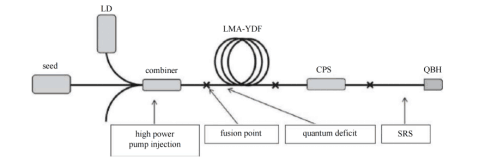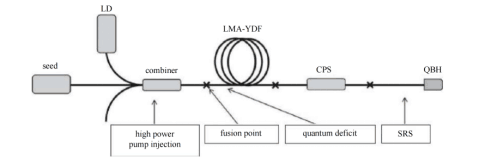I. Background
Fiber lasers, utilizing rare-earth-doped glass fibers as the gain medium, offer a significant advantage in thermal management due to their high surface area-to-volume ratio, which exceeds traditional solid-state lasers by over 1000 times. For fiber lasers in the hundreds of watts range, natural convection is typically sufficient to meet cooling requirements. However, as fiber lasers rapidly advance and output powers reach the kilowatt range, severe thermal effects emerge due to quantum defects and other factors. These effects include stress and refractive index changes in the substrate material, thermal damage to low-refractive-index polymer layers, and, in severe cases, thermal cracking of the fiber. As heat accumulates, the temperature of the doped fiber core increases, leading to higher lasing threshold power, decreased slope efficiency, and changes in output wavelength due to reduced quantum efficiency. To further enhance laser output power, fiber lasers must endure higher pump light powers and greater signal light energy densities, presenting a critical challenge in high-power fiber laser systems.
II. Sources of Thermal Effects in Fiber Lasers
1. Quantum Defect Effect
The quantum defect effect is a primary source of heat in the fiber core and an inherent source of thermal energy. Due to the intrinsic wavelength difference between the pump light and the signal light, all fiber laser systems experience some degree of quantum defect. For example, with a 1080 nm laser output wavelength, the quantum defect for a 915 nm pump wavelength is approximately 15.3%.
2. Various Losses
Fiber coatings can degrade or crack above a critical temperature of 80°C. During high-power continuous operation, fiber coatings are likely to exceed their thermal load limits, leading to cladding light leakage and potential overall damage to the laser. The fusion splicing points of fibers experience significant thermal effects due to two main factors: 1) The absorption of light by fiber materials and recoating materials generates heat. Although nearly transparent recoating layers exhibit minimal absorption over short lengths, microscopic air pockets in these layers increase thermal resistance and cause heat buildup, leading to higher temperatures at the fusion point; 2) Inappropriate fusion parameters or mismatched fiber structural parameters can cause losses at the splice, increasing thermal resistance and temperature at the fusion point. This elevated temperature can damage the fiber and affect its numerical aperture, which significantly impacts light guidance.
3. Spontaneous Emission Effect
In MOPA (Master Oscillator Power Amplifier) configurations, weak signal light combined with a large amount of pump light can increase the probability of fiber spontaneous emission (ASE). ASE results in a large amount of random spontaneous emission light leaking from the fiber core to the cladding and coating, causing overheating and potential destruction of the organic coating. ASE also exacerbates quantum defects, intensifying the heating of the fiber core.


4. Stimulated Raman Scattering Effect
With the advent of ultra-high-power fiber lasers, the laser power density in the core increases, making stimulated Raman scattering (SRS) a significant limiting factor for power scaling. When the laser signal power reaches the SRS threshold, it can excite and pump lower-frequency Raman light, initiating a Raman light amplification process. SRS, along with quantum defects, exacerbates the heating issue in the fiber core.
III. Thermal Management Solutions
Mitigating thermal effects is crucial as they impact both fiber performance and output characteristics. Solutions focus on three main areas:
1. Optimization of Fiber Parameters
Factors affecting fiber temperature distribution include thermal conductivity of the core and cladding layers, radial dimensions, absorption coefficient, and fiber length. Properly selecting fiber parameters can effectively manage heat distribution and ensure stable fiber operation.
Increasing core size can lower core temperature, but excessively large cores may impact beam quality. The coating layer, being the outermost medium for heat transfer, significantly influences operating temperature. Thinner coatings offer lower thermal resistance and smaller temperature gradients, allowing for higher power handling. However, the protective function of the coating and convective heat transfer effects must be considered when selecting thickness.
Fiber cooling in air involves balancing conductive resistance, convective resistance, and total thermal resistance, which are affected by coating thickness. Longer fibers with lower absorption coefficients reduce heat deposition, although they may require longer lengths to maintain the same output. Research by Wang et al. indicates that using a 60-meter fiber with a 0.25 dB absorption coefficient achieves 630W output, while a 20-meter fiber with a 1.0 dB coefficient provides 725W output but with a temperature increase of approximately 200°C.
2. Choice of Pumping Configuration
The choice of pumping structure and method is crucial for achieving uniform temperature distribution and reducing thermal effects. Distributed side-pumping and multi-segment pumping are effective strategies. For example, Jena University demonstrated a kilowatt-level side-pumped fiber laser in 2011, and subsequent developments have led to distributed side-coupled cladding pumped fibers achieving kilowatt outputs. Multi-segment or distributed side-pumping structures can ensure uniform fiber temperature, reduce thermal effects, and shorten fiber length, though challenges include minimizing splicing losses and improving efficiency.
3. Heat Dissipation Design
Heat transfer primarily occurs through conduction and convection, with radiation often negligible. For lower-power fiber lasers, natural convection suffices, but higher-power lasers require specific heat conduction methods to transfer heat to dedicated sinks and ensure effective dissipation.

The contact shape or surface finish between the fiber and heat sink affects thermal conduction. Reducing thermal resistance is key, and filling gaps with high thermal conductivity materials can enhance heat transfer. Theoretical models of thermal resistance between fiber and sink show that effective interface materials can minimize resistance and thus lower fiber temperature.
For high-power lasers, using semiconductor cooling modules (TECs) or water cooling can maintain stable temperatures. For instance, Li et al. employed TECs for external cooling of YDFL with dual-end pumping, achieving effective temperature management.
Conclusion
As high-power fiber laser technology advances, addressing thermal effects remains critical. Effective thermal management solutions—ranging from optimizing fiber parameters, selecting appropriate pumping configurations, to designing efficient heat dissipation systems—are essential for maintaining laser stability and performance. Continued development in these areas promises enhanced power outputs and broader applicability of fiber lasers in various environments.








